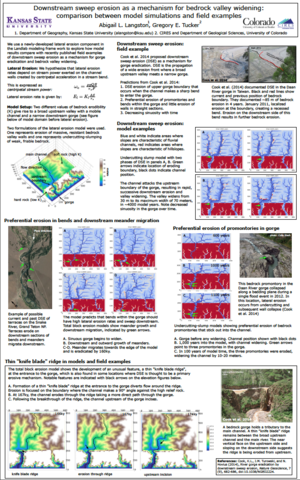Annualmeeting:2017 CSDMS meeting-128
Browse abstracts
Using a landscape evolution model to evaluate the role of pulses of uplift on bedrock valley width and channel mobility

Understanding the factors that control lateral erosion rates in bedrock channels is a frontier in geomorphology. When lateral bedrock erosion rates exceed the rate of vertical incision on the channel bed, wide bedrock valleys are produced; if vertical incision rates then exceed lateral erosion rates, a strath terrace can be produced. Lateral erosion rates and the evolution of wide bedrock valleys are linked to bedrock lithology, sediment supply in the stream, discharge variability, and uplift.
We use a newly-developed lateral erosion component in the Landlab modeling framework to explore how the width of bedrock valleys develops under competition between lateral channel mobility and uplift rate. Two model formulations are presented, one representing the slow process of widening in a bedrock canyon, the other representing undercutting, slumping, and rapid downstream sediment transport that occurs in softer bedrock. We ran modeling experiments with a range of bedrock erodibility, sediment mobility, and uplift conditions. In order to determine the role changing uplift patterns has on channel mobility and bedrock valley width, two modeling scenarios were run: one with a fourfold increase in base level lowering and one with a fourfold decrease in base level lowering. In the total block erosion models, which represent hard bedrock, the migration of knickpoints through the channels controls the onset of changes in valley width. As the channel comes into a new equilibrium slope, lateral erosion is either stalled (in the case of increased uplift) or accelerated (in the case of decreased uplift). In the undercutting-slump models, increasing uplift results in short-lived valley narrowing as the knickpoint moves up the channel. But after the model domain has reached equilibrium, higher uplift results in significantly wider bedrock valleys. This counterintuitive response reflects the nature of the model algorithm, which represents undercutting, slumping, and rapid downstream transport of sediment that occurs in soft bedrock. This class of models shows that in soft bedrock, higher uplift can increase channel mobility and result in wider bedrock valleys, rather than promoting less mobile channels and valley narrowing. Through these model experiments, we evaluate the conditions under which changes in base level fall result in wider bedrock valleys and more mobile channels and conditions under which the opposite occurs.
